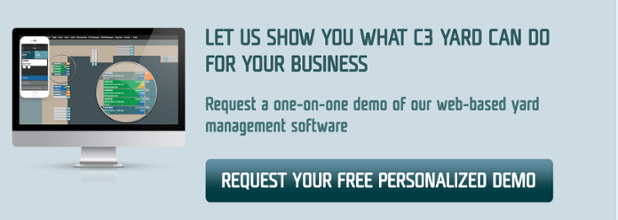5 Must Have Features in a Yard Management Software

Recognizing that a yard management system (YMS) can add value to your operation is easy. You’re losing trailers or having difficulty finding them, your yard drivers’ productivity is questionable and difficult to measure, you’re paying detention fees and there may be congestion at your gate. All these examples are proof you need a YMS, and you know it. Others will have tried to leverage their WMS and TMS for YMS functionality and painfully recognize their respective shortcomings. Given all of these various options how do you select the right YMS for your operation?
To assist you through this process, we’ve come up with 5 must have features that we believe are essential for any YMS. These features will add the most value to your operation and contribute significantly to achieving a successful return on investment.
1. Real Time Visibility on Yard Assets
We consider yard assets to include everything that is managed in the yard, such as, trailers (and their contents), yard trucks, and yard drivers. Having the ability, at the click of a mouse, of knowing where trailers are parked, how many empty trailers are available (or missing) for shipping, who came in and out of the gate, what your yard drivers are up to and whether you’re behind schedule is simply priceless.
Not only is it essential for your own operation to know the exact inventory of the trailers in your yard and their respective contents, it is also very useful to provide this information to your transportation partners. If you use 3rd party carriers’ trailers, providing a web based portal to allow your them to see their equipment on your site is an indispensable tool. Allowing truckers visibility of trailers in your yard allows for reduced detention fees and ensuring that the right equipment is available when you need it.
2. Yard Driver Task Optimization
Managing dedicated yard drivers is the most costly aspect of your yard operation and the most important in terms of your capacity to deliver service to the operation. Effective trailer move/task management is the key to an efficient yard management software. Yard drivers equipped with mobile devices receive trailer-move requests based on business rules and priorities that are optimal for your specific context. A good yard management system should be focused on eliminating trailer move/tasks through combining move requests and optimizing each move to use the least amount of resources. Furthermore, the YMS should be easy to setup yet sophisticated in its optimization algorithms.
3. Dock Scheduling
Visibility on yard assets was our first point and is often the first item on people’s mind when talking about yard management. At a higher level though, it is important to remember that a YMS is about increasing throughput in your yard (moving higher volumes with fewer resources). One way to maximize yard capacity is by scheduling live inbound and outbound loads.
Scheduling live inbound loads provides the facility visibility on the incoming volumes and, through the use of a dock scheduling system that takes into account specific rules and constraints, will smoothen out the workload on your docks. This will alleviate the pressure on space available in your yard and reduce the workload of your jockey drivers. Furthermore, the scheduling system will allow you to plan when to move stored trailers to your docks, in between appointments, and better manage your priorities.
Scheduling outbound loads allows manufacturing and distribution centers similar benefits. With the driver shortage issue and the constant pressure to becoming a shipper of choice, few sites can afford to be 100% drops. For this reason, it is important to consider the scheduling capabilities of your YMS.
4. Gatehouse Management
The key point in looking at a Yard Management Software’s features, in regards to the gate, is whether it will enhance the arrival and departure processes. The gatehouse also plays an important role in the security of the facility as well as it is the first contact with the driver when they arrive on-site. To facilitate gate throughput the yard management system needs to have visibility of arriving vehicles. As indicated in the previous point the inbound plan allows gate guards to easily identify the reason the trailer is on site and to direct it to the proper area in the yard based on the contents of the trailer, rather than waiting on warehouse staff to direct trailers.
In addition, drivers arriving on-site with confirmed appointments can use options such as a self-serve check-in kiosk to further streamline the arrival process, just as the carriers should have access to a web portal so they can monitor the status of their assets on your site .
5. Integration to External Systems
If you wish to leverage the fundamental benefits of a YMS, then you should consider sending and receiving data electronically with your other informations systems. Integration to a TMS or a WMS will eliminate duplicate data entry and maintain continuity between systems.
Furthermore, you can consider Integrating to vehicle telematics systems; allowing your operation to leverage vehicle position data within the yard. A yard management system should utilize standard methods such as web services, allowing for the greatest flexibility and fluidity of information between your systems
Selecting the Right Software Provider
In addition to these 5 points on fundamental YMS features, it goes without saying that your choice in software provider is also very important. Here are a few considerations to keep in mind while shopping for a YMS:
- Service levels - what type of service do you need from this system and is your application mission critical?
- Just as with WMS and TMS systems, yard management is a specialty. However, it is a niche market and for this reason, if you’re considering doing business with a software provider that encompasses many domains, examine how committed they are to the YMS market; from a product development and support perspective.
- On-premise versus software as a service (SaaS) - do you really want to host and support an application internally? Furthermore, if your provider doesn’t offer a SaaS version, examine how current their YMS release is and how committed they are to future product improvements.
A yard management system is an important aspect of any logistics operation as it is the vital link between your facility and transportation. Continuous pressure on improving site efficiency and becoming a shipper of choice underscores the need to find the right solution.

